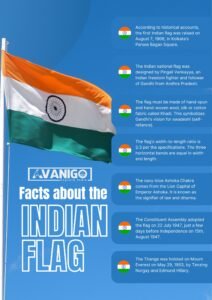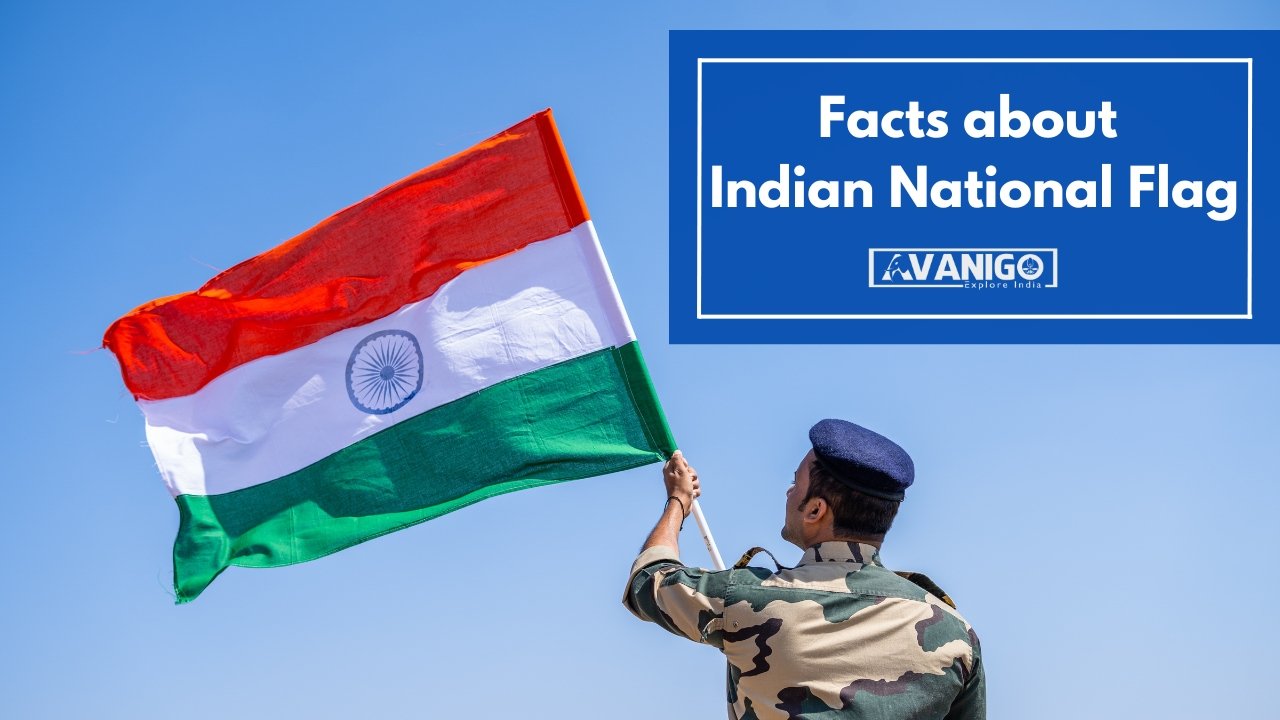Racing towards emerging as one of the super powers in economy and technology, India completed its 77 years of independence. This year on 15th August 2024, India celebrates its 78th Independence Day. The journey to this freedom made a history. It was filled with battles and wars not fought on the border. This battle was fought by inspiring Indians and leaders who even sacrificed their lives, ultimately leading to our nation’s freedom. Indian flag, which represents this one and undivided nation, played a crucial part in this war. Unfortunately, most of us are not very knowledgeable about our flag. As we celebrate 77 years of Tiranga, let us revisit some interesting facts about Indian flag and remind us our of our national pride.
Quick Navigation
Indian National Flag FAQs
According to historical accounts, the first Indian flag was raised on August 7, 1906, in Kolkata’s Parsee Bagan Square. It was a simple flag with three horizontal green, yellow and red bands. Over the next few decades, several modifications were made to this original design. Some key interesting facts about the Indian national flag are:
Why Indian national flag is called tricolor?
The tricolour Tiranga, or Indian national flag, is a horizontal rectangle with three equal bands of saffron, white, and green, with a navy-blue Ashoka Chakra in the middle. On July 22, 1947, the Constituent Assembly had a conference and created the flag in its current shape. The flag was officially recognized as Indian Flag on 15th August 1947, which is our Independence Day.
Who is the Designer of Indian Flag?
The Indian national flag was designed by Pingali Venkayya, an Indian freedom fighter and follower of Gandhi from Andhra Pradesh. He was also a geophysicist and writer.
Manufacturing Materials of Indian flag
- The flag must be made of hand-spun and hand-woven wool, silk or cotton fabric called Khadi. This symbolizes Mahatma Gandhi’s vision for swadeshi (self-reliance).
- Polyester and machine-made flags were allowed only in December 2021 after amendments to the flag code.
- Only four entities in India are licensed to manufacture the flag – in Hubli, Mumbai, Gwalior, and Kanpur.
Dimensions of Indian flag
- The flag’s width-to-length ratio is 2:3 per the specifications.
- The three horizontal bands are equal in width and length.
- The size of the Ashoka Chakra is not defined, but it should have 24 spokes.
What does the Colours of the Indian Flag symbolize?
- Saffron indicates courage and sacrifice.
- White stands for truth, peace and purity.
- Green represents the fertility, growth and prosperity of the land.
What does Ashoka Chakra in Indian flag symbolize?
- The navy-blue Ashoka Chakra comes from the Lion Capital of Emperor Ashoka.
- It is known as the signifier of law and dharma.
- The 24 spokes signify 24 qualities like courage, patience, peacefulness etc.
Official Adoption of Indian Flag
- The Constituent Assembly adopted the flag on 22 July 1947, just a few days before independence on 15 August 1947.
- It became the official flag of independent India after the partition and independence from British rule.
When was Indian Flag First Hoisted?
- The first flag was hoisted by India’s first Prime Minister, Jawaharlal Nehru, at the Lahori Gate of the Red Fort in Delhi on August 15, 1947.
- The first Indian flag unfurled on foreign soil was by Madame Bhikaji Cama in 1907 in Stuttgart, Germany.
Largest Indian Flag
- At 110m x 24m, the most enormous Indian flag in India flies at the Indo-Pak border in Attari, Punjab.
- The world’s most significant human flag formation of 50,000 people was achieved in Chennai 2014.
Rules for Display of Indian flag
The flag code governs the usage and display of the flag with rules like no object higher than it, no touching ground etc.
Flying the flag at night was allowed only in 2009, while ordinary people could display it freely from homes in 2002 after amendments.
Facts about Indian national flag
- The Tiranga was hoisted on Mount Everest on May 29, 1953, by Tenzing Norgay and Edmund Hillary.
- Rakesh Sharma carried the flag to space during the Indo-Soviet Space Mission in 1984.
- The world’s largest national flag, measuring 60 m x 90 m, was flown over the tallest mast, 207 m, at K Shelve Stadium in Karnataka in 2022.
- The world’s largest human chain waving the Indian flag was achieved in 2017 with 1.5 million participants in Bihar.
- Pingali Venkayya, a freedom fighter from Andhra Pradesh, designed the Indian tricolour flag.
- The largest human formation of the Indian flag was achieved by 50,000 volunteers in Chennai, covering an area of about 37,000 sqm.
- The Ashoka Chakra was adopted from the Lion Capital of Ashoka at Sarnath.
- The Indian flag flew above the Red Fort for the first time on August 16, 1947, after independence.
- The Karnataka Khadi Gramodyoga Samyukta Sangha (KKGSS) makes around 20 million flags per year.
- In 2004, Naveen Jindal won a decade-long legal battle that enabled all citizens to display the flag freely.
- The first Indian flag had eight lotuses representing the eight provinces of British India. It also contained Vande Mataram in the Devanagari script.
- The flag must be flown on the VIPs’ right side and replaced when damaged or faded.
- Mahatma Gandhi was initially given the flag’s current design in 1921 at a gathering of the Indian National Congress in Vijayawada. It was in the meeting of the Constituent Assembly that the flag was officially accepted as the national flag of India.
- The only modification to the flag when India became a republic on January 26, 1950, was the removal of the George Cross, a representation of the British monarchy, from the centre.
- A team of mountain climbers from HMI (Himalayan Mountaineering Institute) unfurled the largest Indian Tricolor at the highest mountain in Antarctica. This golden memory was created on December 3rd, 2021. The length of the flag was 7500 sq ft.
- In 2004, Naveen Jindal filed a Public Interest Litigation to give Indian citizens the right to display the flag freely. The Supreme Court ruled in his favour leading to the amendment of the flag code.
- The largest human flag was formed in Chandigarh in 2014 during the Swachh Bharat Campaign. Over 5200 students created the flag measuring about 1000 feet by 1500 feet.
- The largest pixelated Indian flag was created in 2021 using over 5000 people wearing custom T-shirts at an event organized by the Government of Haryana.
- India holds the world record for the largest human image of a waving national flag, achieved by 58,405 people in Chennai in 2019 during a cultural festival.
- A 6400 square feet flag was displayed in 2018 during the Republic Day parade in Rajpath, New Delhi, breaking the previous record of a 4800 square feet flag.
- The Indian flag was unfurled on the moon by the Vikram lander of India’s Chandrayaan-2 space mission in 2019. However, contact with the lander was lost before touchdown.
- National flags signed by astronauts who carried them to the moon have been auctioned for hefty prices.

Significance of the Indian Flag
The Indian national flag holds deep significance for the country and its citizens. Some prominent aspects that are a part of interesting facts about the Indian flag are:
Patriotism and Pride: The flag inspires feelings of patriotism and pride in a nation. It stands for the aspirations and hopes of the Indian people. Citizens proudly display the flag on national days like Independence Day and Republic Day.
Unity in Diversity: The saffron, white and green colours symbolize unity in diversity. They represent all faiths and communities living peacefully in one country.
Courage and Sacrifice: The flag stands for the courage and sacrifice of the freedom fighters. It reminds us of the struggles millions face to win independence for the country.
Progress and prosperity: The chakra represents the dynamic and progressive path that India has chosen. The green colour indicates prosperity and growth.
Peace and Truth: The white colour band signifies peace, harmony and truth. The Ashoka Chakra also represents the eternal wheel of law or dharma.
Respect for the National Flag: Flag Code of India
- The specifications of the flag are compiled in a document called the ‘Flag Code of India, 2002‘. It governs the display, usage and manufacturing processes of the flag.
- The flag code dictates that the Indian flag must be treated with dignity and respect.
- Damaged or soiled flags should not be publicly displayed but destroyed privately and respectfully.
- There are strict rules about the size, colour specifications, hoisting and usage of the flag.
- Desecration of the flag is punishable under the Prevention of Insults to National Honour Act of 1971.
- Citizens must stand in attention when the Indian national anthem is played in honour of the flag.
Conclusion
The Indian tricolour flag is an iconic national symbol that evokes a deep sense of patriotism and national pride. Its evolution over the decades reflects the spirit of a free India. The thoughtful symbolism behind each component represents the country’s secular values, culture and progressive philosophy. Every Indian must know these interesting facts about the Indian flag and respect the flag code and honour the tricolour that is a reminder of the countless sacrifices of our freedom fighters. The saffron, white, and green flag flying high represents the soul of a proud nation.
At AvaniGo, we are passionate about India and its mesmerizing culture. We intend to share the greatness of Indian culture through our articles. To learn more about us and contribute to our website, email us at hello@avanigo.com.

